Find more information in the General Comments section of the assessment
Find more information in the Rating Validity tab of the assessment
- See More
- See More
- See More
- See More
- Good
- Adequate
- Marginal
- Weak
- Poor
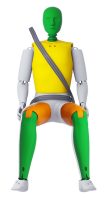 Passenger
Passenger
 Driver
Driver
 Front Seat
Front Seat
 Car
Car
 Pole
Pole
- Good
- Adequate
- Marginal
- Weak
- Poor
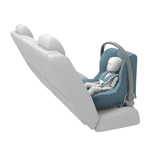
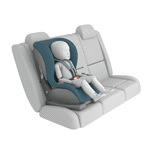
Passenger
outboard
center
Fitted to the vehicle as standard
Not fitted to the test vehicle but available as option
Not Available
Based on dummy results in the frontal and side impacts, the Transit Custom scored maximum points for its protection of both the 18 month and 3 year infants. In the frontal impact, forward movement of the 3 year dummy, sat in a forward-facing restraint, was not excessive and, in the side impact, both dummies were properly contained within the protective shells of their restraints, minimising the likelihood of head contact with parts of the vehicle interior. The front passenger airbag can be disabled to allow a rearward-facing child restraint to be used in that seating position. Clear information is provided to the driver about the status of the airbag and the system was rewarded. The dangers of using a rearward-facing restraint in that seat without first disabling the airbag are clearly labelled on the vehicle interior.
- Good
- Adequate
- Marginal
- Weak
- Poor

Head Impact 12.0 Pts
Pelvis Impact 0.0 Pts
Leg Impact 2.3 Pts
The bumper provided mixed protection to pedestrians' legs with good protection in some areas and poor or marginal protection in others. Similarly, in those areas likely to be struck by the head of a child or that of an adult, protection was mostly poor or marginal but was good in some areas. Assessment of the front edge of the bonnet was not appropriate owing to the shape and height of the vehicle.
- Good
- Adequate
- Marginal
- Weak
- Poor
| Performance | ||
| Vehicle Yaw Rate @ COS + 1.00 s | 2.112% | meets ECE requirements |
| Vehicle Yaw Rate @ COS + 1.75 s | 3.334% | meets ECE requirements |
| Lateral Displacement @ BOS + 1.07 s | 2.577 m | meets ECE requirements |
| Applies To | Driver's seat | ||
| Warning | Driver Seat | Front Passenger(s) | Rear Passenger(s) |
| Visual | |||
| Audible | |||
|
|||
The Transit Custom has electronic stability control as standard equipment on passenger-carrying and commercial variants. A seatbelt reminder for the driver is also standard equipment. A driver-set speed limitation device is not fitted to all variants but is standard equipment in more than half of vehicles sold and met Euro NCAP's requirements for fitment and functionality.
- Specifications
- Safety Equipment
- Videos
- Advanced Rewards
- Rating Validity
Specifications
Tested Model Ford Transit Custom, 2.2 diesel 'Trend' Kombi, LHD
Body Type - 8/9 seater van
Year Of Publication 2012
Kerb Weight 2091kg
VIN From Which Rating Applies - all Transit and Tourneo Customs, including PHEV, with the safety specification tested
Class Large MPV
Safety Equipment
Note: Other equipment may be available on the vehicle but was not considered in the test year.
Fitted to the vehicle as standard
Fitted to the vehicle as option
Not fitted to the test vehicle but available as option
Not Available
Not Applicable
Videos
Advanced Rewards
Rating Validity





Find more information in the General Comments section of the assessment
 Share
Share
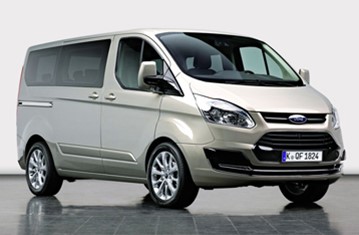


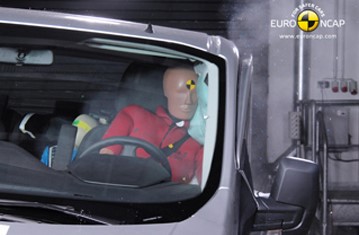

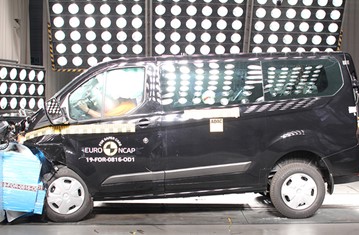
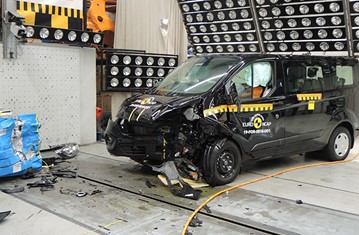

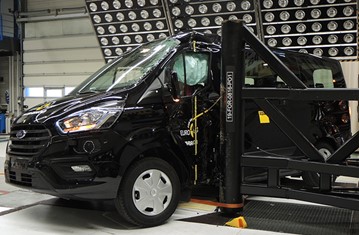



The passenger compartment remained stable in the frontal impact test. Dummy readings indicated good protection of the knees and femurs of the driver and passenger dummies. However, structures in the dashboard were thought to present a risk to occupants of different sizes or those sat in different positions. The Transit Custom scored maximum points in the side barrier test with good protection of all body regions. In the more severe side pole impact, protection of the chest and abdomen was adequate while that of the head and pelvis was good. Whiplash protection was assessed by analysing the geometry of front and rear seats and head restraints. The assessment revealed marginal protection against whiplash in the event of a rear-end collision.